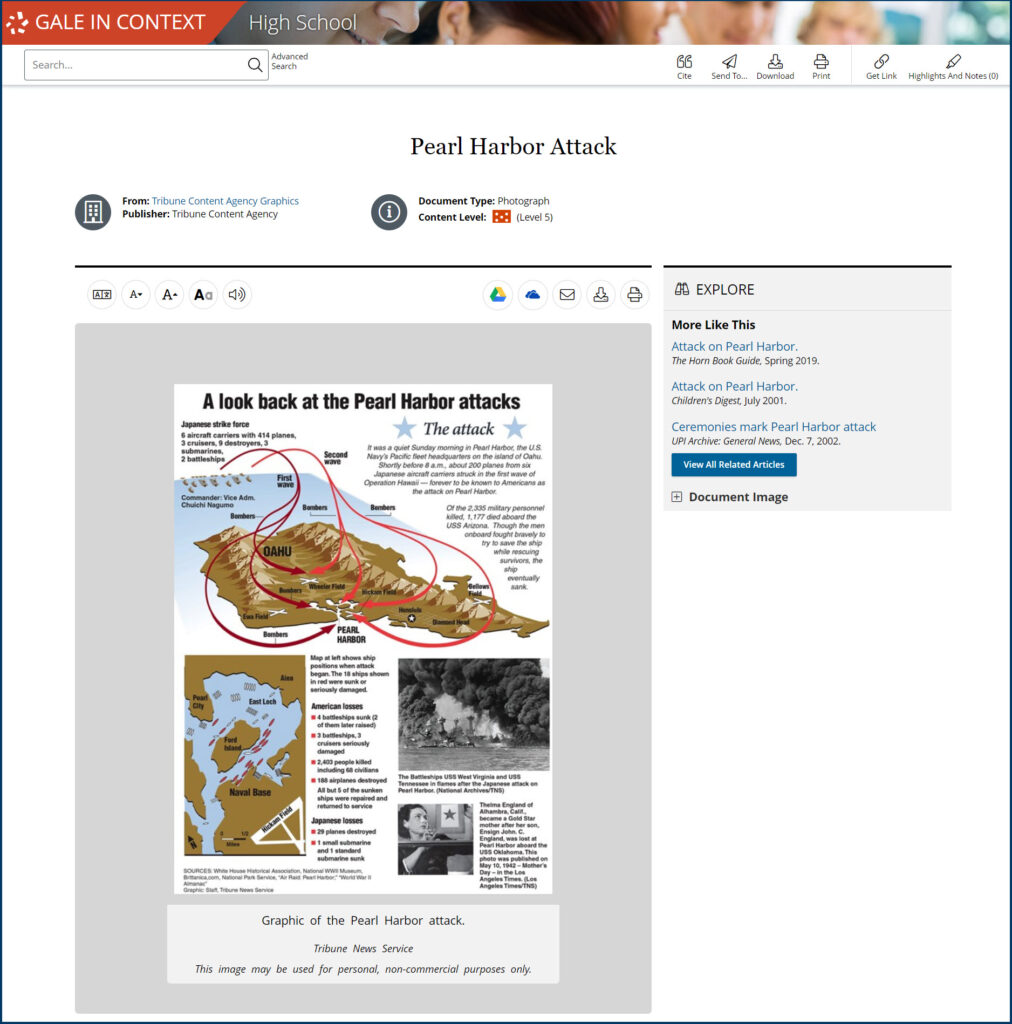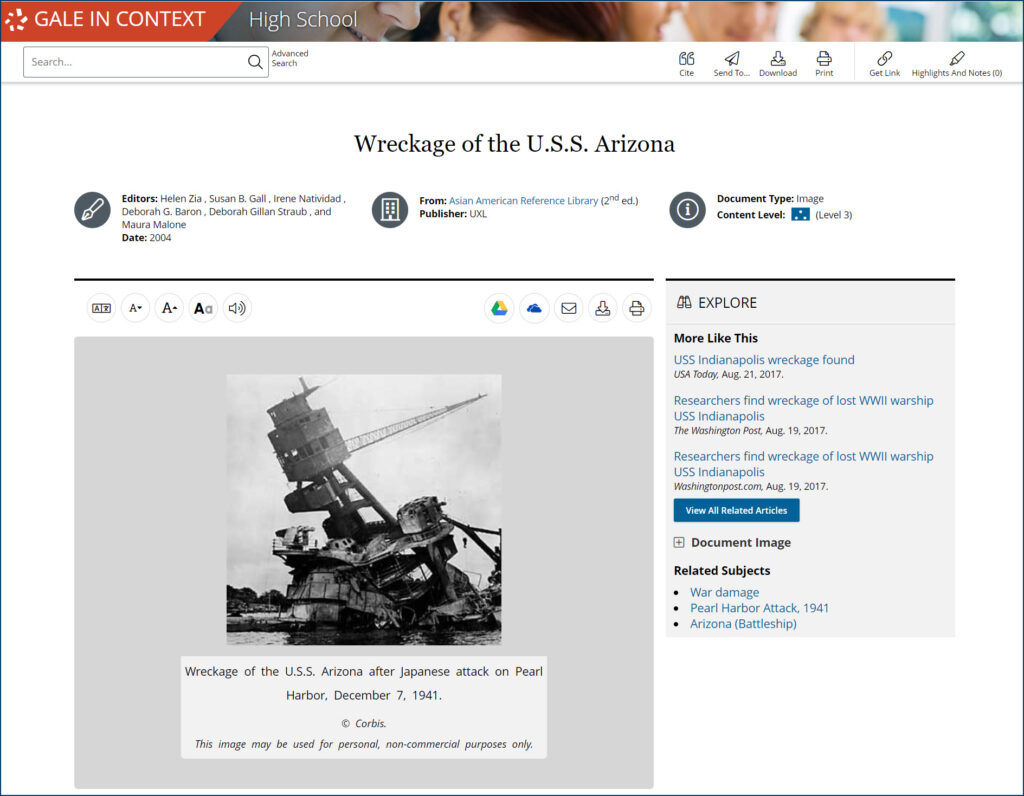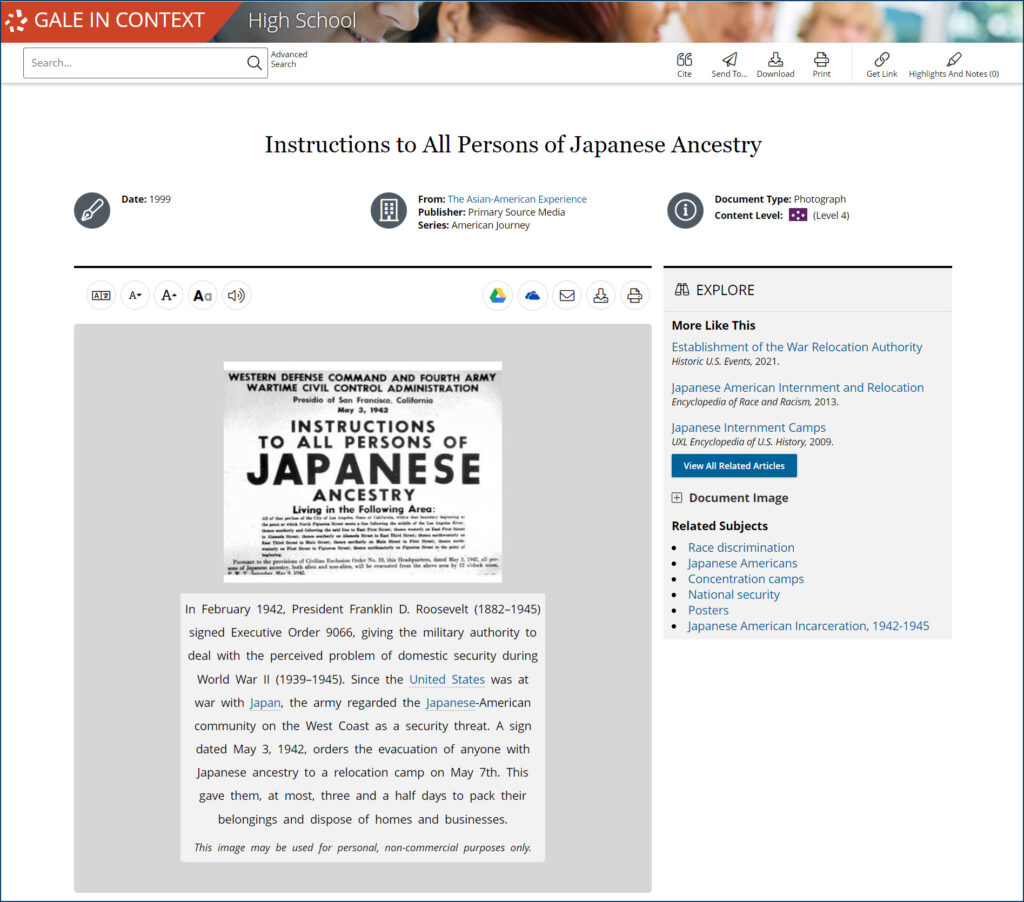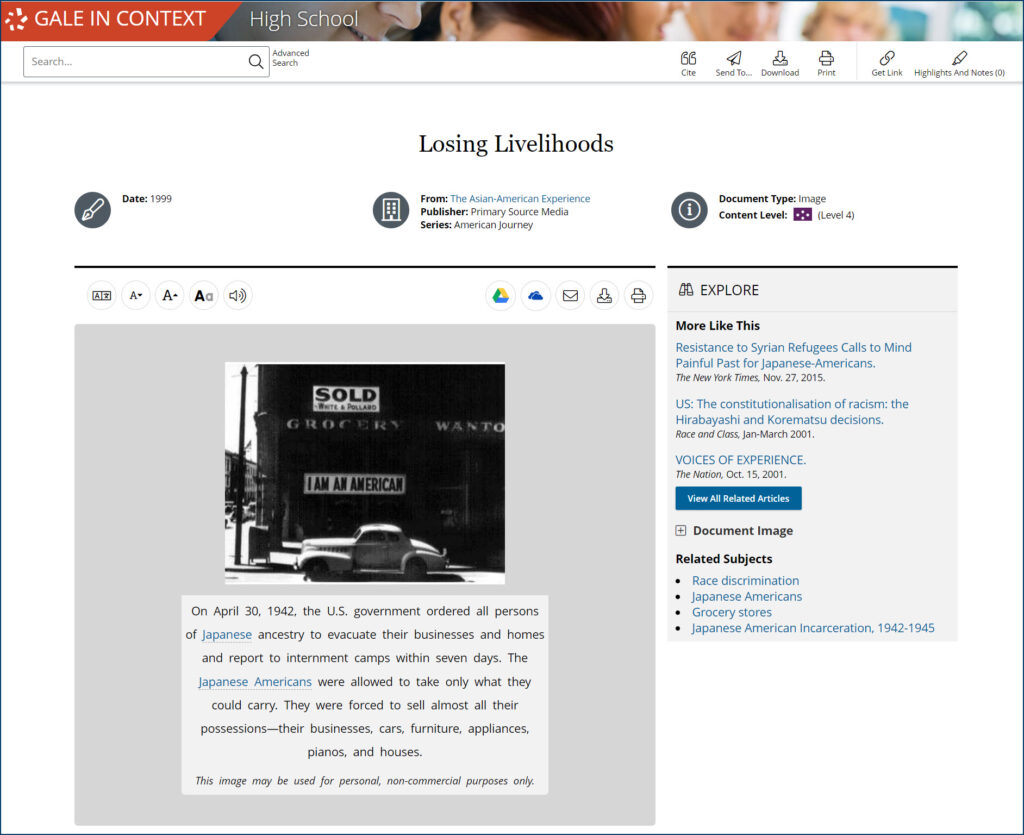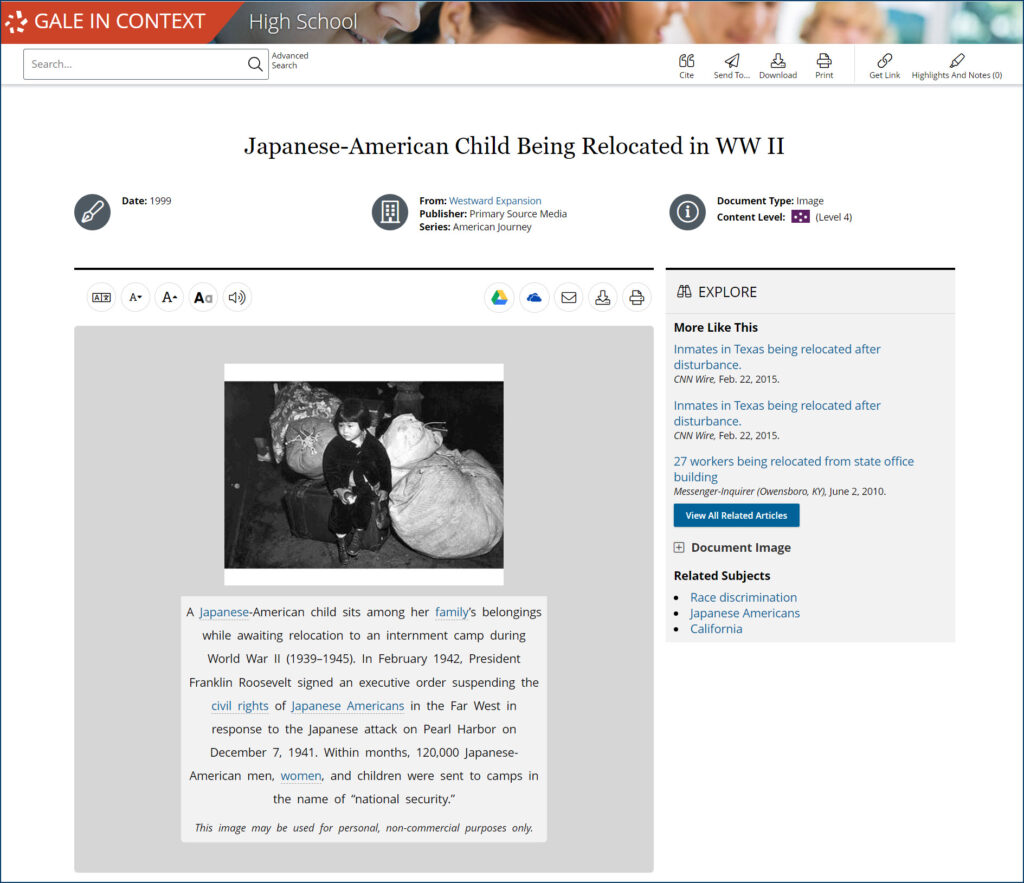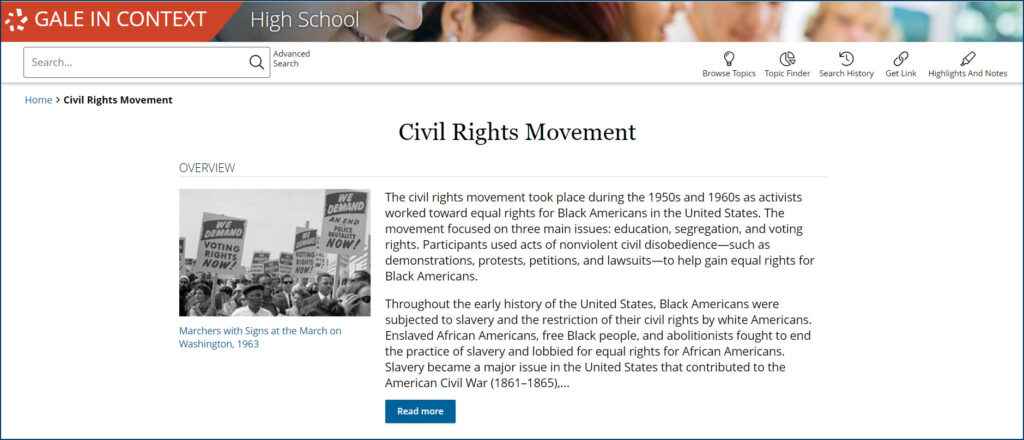| By Gale Staff |
In the early hours of December 7, 1941, a surprise attack on Pearl Harbor claimed more than 2,400 American lives. In 1994, Congress established National Pearl Harbor Remembrance Day to honor those who perished. And still today, even after more than 80 years have passed, thousands gather at the Pearl Harbor National Memorial annually on the anniversary of the attack.
Yet, as the years pass, the number of survivors dwindles. As of April 1, 2024, only 19 remain. Keeping this history alive for future generations has become increasingly urgent—as does our need to come to terms with the painful and ugly reality of the subsequent internment of Japanese Americans.
With the support of the Pearl Harbor topic page on the Gale In Context: High School platform, educators can pass the story and legacy of Pearl Harbor, as well as its dangers and lessons, on to a new generation.
Access to Gale In Context: High School means students and educators can engage with trustworthy, educator-vetted multimedia reference materials and compelling primary sources, such as a transcript of Franklin Roosevelt’s fireside chat declaring war on Japan and a gripping eyewitness account from Senator Daniel K. Akaka, who saw the devastation from his high school classroom.
The Attack on Pearl Harbor
As dawn rose on a seemingly peaceful Sunday, the tranquility of Pearl Harbor—a major fueling station for military assets—was shattered by the Imperial Japanese Navy’s sudden, unprovoked assault.
At 7:55 a.m., Vice Admiral Chuichi Nagumo launched the first wave of Japanese torpedo planes. Dive bombers, level bombers, and fighter planes descended upon the unsuspecting U.S. Pacific Fleet. Accompanying these aircraft were waterborne vehicles, including two battleships, 11 destroyers, and 35 submarines.
Within minutes, American ships and airfields were under siege, with explosions and gunfire tearing through the stillness of the Hawaiian morning.
The attack was devastatingly effective. By the time the second wave of planes had completed their mission, eight battleships were damaged—four sunk—along with three cruisers and nearly 200 aircraft. The human toll was equally staggering: 2,403 Americans lost their lives, and another 1,178 were wounded. Nearly half of the casualties occurred on board the USS Arizona as it was engulfed in flames.
This surprise attack was a calculated and strategic move by Japan, as it sought to debilitate U.S. naval power in the Pacific, thus paving the way for Japan’s expansion across Southeast Asia. Instead, it galvanized the American spirit, and a swift declaration of war against Japan was forthcoming on December 8, 1941.
During his national address, a video of which is available through Gale In Context: High School, President Franklin D. Roosevelt declared December 7 “a date which will live in infamy.” He continued, giving voice to the nation’s outrage: “No matter how long it may take us to overcome this premeditated invasion, the American people in their righteous might will win through to absolute victory.”
Lesson Idea: Perspectives on Pearl Harbor
History is more than a black-and-white chessboard of opposing sides. Using Gale In Context: High School’s collection of biographies, students can dig into the complex human motivations and dilemmas behind Pearl Harbor and the pressures they faced in the aftermath.
- Fred Korematsu, a Japanese-American civil rights activist who challenged the legality of the internment camps.
- Abraham Johannes Muste, a pacifist who was a vocal member of the anti-war movement and opposed American involvement in WWII even after Pearl Harbor.
- Franklin D. Roosevelt, president of the United States during Pearl Harbor.
- George S. Patton, a military commander remembered for his strong leadership and aggressive wartime tactics.
- Shigetaro Shimada, Japan’s minister of the Navy who approved the Pearl Harbor attack.
- Yoshiko Uchida, an award-winning Japanese American author who wrote a children’s series, starting with Journey to Topaz and its sequel Journey Home, about her experiences in the internment camps.
- Isoroku Yamamoto, the Japanese admiral who planned the attack on Pearl Harbor despite his reluctance to bring the United States into the war.
We also provide suggestions for related articles at the bottom of each page to encourage readers to dive deeper into the lives of major players and driving ideologies, such as isolationism, social gospel, and unionization.
Japanese Internment: ‘The Single Most Traumatic and Disturbing Experience’
The impact of Pearl Harbor extended far beyond the battlefield. Rather than seeing the attack as having been orchestrated by Japan’s military leaders, the Japanese people—including thousands of innocent Japanese Americans—were implicated.
President Roosevelt signed Executive Order 9066 on February 19, 1942. This decision suspended Japanese Americans’ civil rights and authorized their removal from the West Coast to inland “relocation centers.” Over the next six months, 120,000 people of Japanese descent were removed from their homes, stripped of their property, and dispersed between 10 isolated internment camps located in Arizona, Arkansas, California, Colorado, Idaho, and Utah. More than two-thirds were U.S. citizens.
Students who had been living ordinary lives just months before suddenly found themselves imprisoned behind barbed wire, their education and futures interrupted by fear and prejudice. Despite these devastating circumstances, the residents of these camps made the best of the situation, creating communities with newspapers, markets, and public services. Soon, makeshift classrooms welcomed students as schools were established, complete with extracurricular activities like band, senior prom, student council, and yearbooks.
Japanese Americans serving in the U.S. military weren’t spared from incarceration, either, as was the case with future U.S. senator Spark M. Matsunaga. During a speech before a Senate hearing on March 18, 1980, he poignantly described the toll of Executive Order 9066:
“Of the 120,000 Americans of Japanese ancestry and their parents who were evacuated from the West Coast and placed in detention camps . . . Not one, I repeat, not one, was convicted or tried for or even charged with the commission of a crime. As a consequence of their evacuation, they lost their homes, jobs, businesses, and farms. More tragically, the American dream was snuffed out of them, and their faith in the American system was severely shaken . . . It remains the single most traumatic and disturbing experience in the lives of many Nisei [children of Japanese-born immigrants born in a new country].”
Lesson Idea: Lead Discussions With Gale’s Critical Thinking Questions
While discussing the complex and often painful aspects of history can be challenging in high school classrooms, they are necessary to foster deeper thought about otherwise abstract topics like justice, equality, and the consequences of fear-driven policies.
To help teachers spark structured, thought-provoking discussions, many of the reference documents from the Gale In Context: Online Collection provide compelling questions that guide students in exploring these challenging subjects. For example, the entry on Japanese American Incarceration/Internment provides questions designed to help students connect historical events to modern issues while considering the ethical and social implications:
- Why do you think Japanese Americans began speaking out about their incarceration during the civil rights movement?
- Why do you think it is important for all Americans to understand the history of Japanese American incarceration during World War II?
- How is the treatment of Japanese Americans after Pearl Harbor similar to the treatment of Muslim Americans after 9/11?
Furthermore, Gale In Context: High School has numerous resources about topics that provide further context when discussing these questions, such as the Civil Rights Movement and 9/11 topic pages.
Turning Pearl Harbor’s Legacy Into Lessons on Leadership
Every December 7, we are reminded that as the number of Pearl Harbor survivors dwindles, so too does our direct connection to the lived experiences of that day. Yet, we must also confront the complicated truth that the attack on Pearl Harbor was a catalyst for a hasty, prejudiced decision to intern thousands of Japanese Americans.
Passing these stories on is not just about keeping history alive, as we also encourage the next generation to learn from past mistakes and make decisions informed by the past—but not bound by it. While we honor the bravery and sacrifices made during the attack, it’s equally important to reflect on how pride and the desire for retribution can overshadow our humanity.
In this way, the lessons of Pearl Harbor become a guide for a more thoughtful and just future, in which we understand that true strength in leadership lies not in our victories but in our ability to practice measured, empathetic decision-making.
Discover the power of interactive history by requesting your trial of Gale In Context: High School today! Our platform complements traditional resources, inviting students to engage with an ever-growing library of resources that encourage them to question, analyze, make connections, and immerse themselves in a living dialogue that continues to shape our world.



